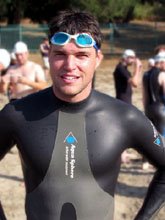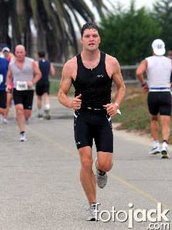Last week I went to lift some weights at the local gym—I figure Macbeth should be sort of a buff type, being that he swings a broadsword for eight hours a day—and found that many of my mainstay movements were uncomfortable on account of the low-back strain I incurred a few weeks ago. Deadlifting, for instance, one of my favorites because my knuckle-dragging arm length makes it one of my better lifts, was out because my back felt a twinge every time I leaned over to grab the bar.
As a trainer, I frequently say, with barely-disguised bravado, that I can work with anyone in any kind of shape with any sort of injury. I have to admit that’s probably—well, okay, definitely—an exaggeration. I’ve met real people who can really work around injuries and they are a sight to see. Wizards of the field. I’m getting there, but heaven knows I’m not there yet.
Still, I SHOULD be able to work around a strained lower back. Any Bally’s clipboard-jockey in my situation can be ultra-conservative and just avoid any movement that activates the low-back. But it’s the mark of a real pro to be able to work the whole body safely even when there’s an injury dogging one particular link in the kinetic chain.
So I poked around in the recesses of my mind for a movement that mimics the action of the deadlift but doesn’t strain the lower back. The first thing that came to mind was the step-up.
Step-ups are mostly a hip-extensor exercise, meaning that the prime movers are the glutes and hamstrings, with the major synergist being the quadriceps. There's some inane debate about this, among people who are even geekier than I am, but that's the conventional wisdom It’s a simple exercise: just stand with your right foot up on a bench and…wait for it…STEP UP on the bench. Then step down with your left foot again and repeat the move for the required reps. Then switch sides and repeat.
Easy, right? Well, yes, in fact, and therein lies the problem. Step-ups are a great rehab move, and they’re great for people just starting out, but they sort of wear out their welcome after awhile because if you’re in shape it can take about fifty reps before you can even notice that you're working out. Sure, you can grab weights in your hands or across your shoulders, or you can do power step-ups, where you're jumping on every step, but then we run into potential low-back straining territory again, the very thing I was trying to avoid.
So, how to make a body-weight step-up an advanced training exercise?
Thus was born the Peg-Leg Step Up.
While performing regular step-ups, I noticed I was generating a lot of momentum by pushing off my bottom foot. What if I could eliminate that “help”? How much harder would it be?
So I flexed my left foot, hard, as if trying to touch my left kneecap with my left toes. With my toes pointed up, only the heel of my left foot was in contact with the floor, my other foot on the bench. My left foot was now a peg-leg, with all my weight driving straight down from my hip to my heel and into the floor. I attempted the exercise again without the aid of any push-off from my left foot.
Night and day. Suddenly, I had to generate all the power from my right leg, and it was tough. I didn’t allow the ball of my left foot to touch the floor at all, because as soon as it did, it wanted to help. It was almost funny watching my body trying to figure out this new self-imposed handicap. I could only do about 12 reps! Suddenly, step-ups were hard again, and I was happy.
The second set was strangely easier, and I quickly realized why: Even though I kept my “down” leg in the peg position, I realized I was using my upper body to generate some extra momentum, as if prepping for a standing long-jump, so I remedied the situation by performing the rest of the sets with my hands behind my back. That drew some stares, and seeing myself in the mirror I came up with my first hypothetical name for this move, the “straightjacket step up,” because I looked like an asylum inmate trying to get some exercise…not that much different from how I usually look in the gym, come to think of it.
Set three gave me another idea: it takes some coordination, but it’s easier on the knee of the free-leg if you soften your ankle and knee a little on the way down, meaning that the free foot is flexed (“pegged”) on the way up , but not on the way down. You just have to make sure that your free leg is locked before you start the step-up move with your working leg so the working leg gets ALL the benefit from the move. Otherwise, you'll unlock your supporting leg and push off, robbing your stepping leg of a few joules of effort.
The lesson here, besides having a great new move to add to your repertoire, is that the body will try to do whatever you tell it in the most efficient way possible. The second an exercise gets too hard, you’ll enlist help from your low-back, traps, momentum generated by the upper body, wherever, in order to move the weight. Strength training is often counterintuitive in this way: you are often performing movements that are rather inefficient in an effort to build up specific areas that are hard to target with more natural movement. Nearly every arm exercise, for instance, falls into that category. If asked to lift a heavy object from waist level to shoulder height, who in their right mind would stiffen the back, straighten the legs, pin their elbows to their sides and move only the forearms, approximating a barbell curl? No one, that’s who. We’d probably more likely do something closer to a power clean, getting some help from the hips, legs and back to heft that load up as quickly and easily as possible.
But I digress. All hail the Peg Leg Step Up, or, if you prefer, The Straightjacket Step Up. if you're without a gym, or your back is bugging you, or you just don't feel like hauling the 60-pounders over to the bench for standard step-ups, they're a great, if weird-looking, alternative. You heard it here first.
Andrew
Wednesday, September 12, 2007
Subscribe to:
Post Comments (Atom)




4 comments:
Hey, Andy, good observations. I regularly do step ups of some variation in most cycles of my training;explosives in particular get rotated in regularly.
think I've pretty much avoided using the grounded leg for any momentum, but it's hard because that leg is naturally loaded, ready to go. There's surely got to be some unconscious assistance, but I know I've kept it minimal.
Still, that's a neat trick you figured out to help ensure otherwise. I'll have to try that next time I'm doing those.
One other trick: focus, focus, focus! LOL
This post was fortunate timing for me, since I tweaked my back stacking hay bales a couple of days ago. (Damn cat tripped me.) I'll be giving this a try.
Been meaning to post this for a while...
Instead of putting yourself in a straight jacket, proper scapular retraction really works the same way. Getting those shoulder blades back and down will really lock those arms into place. At least, they should. And you don't look quite as weird, looking like a speed skater or something.
Quite effective info, thank you for this post.
Post a Comment